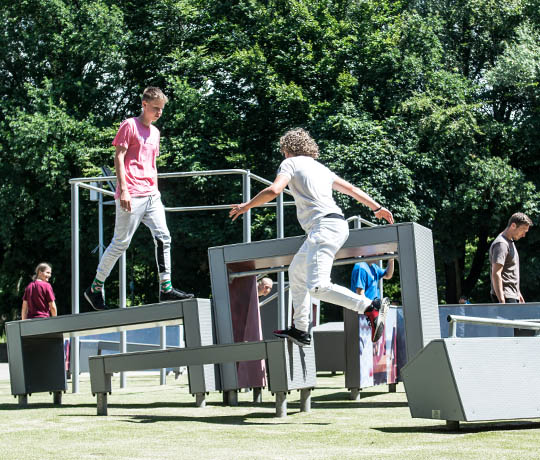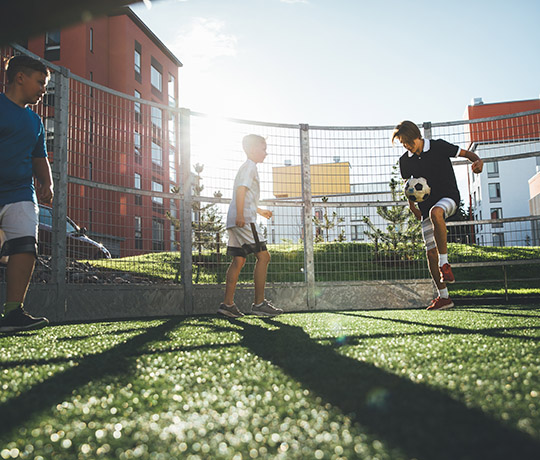Young people’s self-organised physical activity has a strong social aspect
Elina Hasanen writes about the informal ways young people engage in physical activity when the facilities for this in the local community become highly significant. Where teens group together to spend their free time is where opportunities for self-organised physical activity should also be.
We should provide suitable conditions to encourage young people to exercise
Much of the physical activity and exercise that young people engage in is self-organised and unstructured. Kids hang out and play sports in the park, exercise their muscles, hunt for Pokémon, etc. – physical activity takes all forms and changes from day to day.
Catering for spontaneous pursuits through built facilities is more difficult than for organised activities because how and why these activities take place is outside the control of the adults. Kids move when and where they feel like it. Their interests may change on a daily basis.
However, these self-organised forms of physical activity are highly important, and we should do our best to provide suitable conditions to encourage them. It hardly needs to repeat how beneficial physical activity is for a person’s well-being.
For young people, however, the health benefits are probably not the primary incentive for exercise, and the positive effects of activity go much deeper than that: supporting self-organised forms of physical activity is supporting young people’s autonomy and creativity as well as their social skills and, ultimately, participation in society.

Teenagers sitting on Chillout benches
Put ourselves in the shoes of a teenager
To know what makes young people move and how to encourage that, we need to be better tuned in to the way they perceive the world.
So, let’s put ourselves in the shoes of a teenager and picture a typical day. The school day is over, or it’s the weekend or the school holidays have started.
- What type of things will be happening around us?
- Where do we spend our free time and with whom do we share the spaces and events in our lives?
- What would we be spontaneously inclined to do, and what would the options available to us be like?
Our lives are made of elements, and only some of them can be freely chosen. However keen we might be to engage in self-organised physical activity, our environments will ultimately restrict our choices. The physical activity should offer us something that we value and at the same time be easily accessible. As teenagers, when we look around us, wondering what to do with our time, what do we see?
Own goals motivate
At best, engaging in self-organised activity is something we are empowered to choose ourselves and is therefore of genuine value.
But what makes the activity valuable may not be predictable at all. For some, sure, physical activity offers valuable experiences because of the usual meanings associated with exercise: skills, success, fitness, and health, among others.
However, for some these benefits may be secondary. What may be even more important when engaging in self-organised activity is to be able to play, fool around, and have fun, in other words, dictate your own goals instead of thinking about what others consider important.

The Toro Interactive sports arena is a colourful multipurpose playground

Teenagers doing parkour
Things need to be in place
Many things need to be in place before a young person can move in ways that are meaningful to them and bring them joy.
- There needs to be an accessible space where engaging in an activity feels like a free choice.
- There needs to be a time when there is room in this space for this activity.
- And, in addition to space and time, there needs to be the right type of encounters taking place.
Such encounters give a sense of belonging to the place and to the group. Similarly, the wrong type of encounters creates a sense of exclusion and a need to step out of the way of those with more entitlement to the place.
It's not just about the environment
A physical environment can be small or large, built or natural, fenced off, or open. These things matter. Environments have other dimensions apart from their physical characteristics: they are places where social and cultural encounters happen. The framework for physical activity is made up of more than the physical parameters.
The way environments are used also depends on norms, what young people themselves consider valuable, and the relationship between people who use the environment at the same time. For example, there are norms governing behaviour in public playgrounds, which are primarily aimed at young children.
The cultural preferences of the young may influence their choices between different forms of physical activity. Relationships with other people sharing the space are particularly important. Teenagers might be having hours of great fun sledding, as long as there are no adults or little children around. Or a smaller girl may have to step aside on a basketball court when older boys come and play.

Girls practising parkour in a public park in Dobele, Latvia

Lappset`s panna play arena in a housing association garden in Vantaa, Finland
The social dimension of places
The social dimension of places for physical activity cannot be overemphasised when it comes to teenagers.
Teenagers’ choices about how they spend their free time are strongly influenced by a need to be together with certain or particular types of people or, in contrast, a need to withdraw into solitude. These aspirations are often much stronger motives behind a choice of physical activity than the benefits of the activity per se.
Physical activity may only be a vehicle for something more important, and a young person might engage in it to be part of a group, or, to enable them to withdraw from the company.
Social needs in teenager’s daily life vary
- A fifteen-year-old girl might hang around the sports ground in her neighbourhood and join the game with the aim of chilling out with others and getting to know them socially.
- Another might prefer a walk in the woods with a friend, as this provides privacy and peace to talk.
- A third may be playing games in an activity park while looking after and enjoying her time with a younger sibling.
- One might go to the gym one day to be with a friend who is into weight training and choose to sit at the mall the next day to be part of another social group.
The social needs in a teenager’s daily life are many and varied – and the same goes for incentives to move or not to move.

Girls taking selfies

Boys having fun at an outdoor gym
The possibilities for a physical activity must be where the young people are
What matters is what the young person has around them at the moment they decide what to do next, and where to direct their energy. Exercise should be a valid option at those moments when there is time for it. The possibilities for physical activity must be there where the young people are: where they live, where they hang out with friends, the routes they take during their daily travel and movements, and where they willingly choose to be.
What is there within easy grasp will be grasped.
So, what if the places where teenagers hang around were equipped with structures that withstand and even encourage climbing and gymnastics, instead of simply having benches to sit on? What if public spaces and residential areas were designed to include elements that encourage people of all ages to move more? Would such structures make adults take that extra step, too?
Freedom to have fun
Exploring your environment by moving in it makes the environment more familiar, safer, and easier to form an attachment with. These considerations are not at all irrelevant to the happiness of our young people or to their developing into thriving members of their community and society.
Spontaneous activity does not always fit within the institutional boundaries of organised sports, and that’s precisely why it is so important. The freedom of just having fun with physicality deserves to be acknowledged.
So, what if the places where teenagers hang around were equipped with structures that withstand and even encourage climbing and gymnastics, instead of simply having benches to sit on?
What if public spaces and residential areas were designed to include elements that encourage people of all ages to move more?

The freedom of just having fun with physicality deserves to be acknowledged.
This blog is based on the writer’s doctoral dissertation: “We’re on the move all the time”: A study on the forms and meanings of young people’s self-organised physical activity in the framework of space. http://urn.fi/URN:ISBN:978-951-39-7204-2
Bibliography:
- Hasanen, E. 2017. Nuorten omaehtoinen liikkuminen – Arkeen sopivia, merkityksellisiä palasia.
- Liikunta & Tiede 54 (6), 9–12.
- Kivijärvi, A. 2014. Piilossa kasvattajilta: nuoret ja hengailutilojen viehätys. Teoksessa Mutta mikä on tutkimuksen teoreettinen kysymys? Joensuu: University Press of Eastern Finland, 120–136. Massey, D. 2005. For Space. London: Sage.
